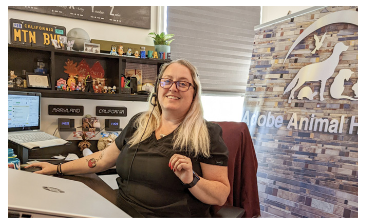Written by Kate Boatright, VMD
(Article published in Trends Magazine, an AAHA publication, in March 2023)
In the lobby of the Anywhere Veterinary Clinic, a client is checking in for their appointment with a bouncing Labrador retriever at the end of the leash. Another client is waiting to check out with their very stressed cat in a carrier growling at the exuberant Labrador, and a third client has just walked in to pick up their dog’s monthly preventive products. Two overwhelmed client service representatives (CSRs) are trying to help the clients in front of them while being interrupted by a frequently ringing phone and knowing more clients are waiting on hold with questions about their own pets. Sound familiar? Is there a better way to deliver customer service to our veterinary clients—both in the clinic and over the phone?
A New Delivery Model for Client Services
Imagine if we could simply remove the ringing phone from the equation. Client conversations with CSRs would no longer be interrupted, while in-person clients—as well as those on the phones—would have shorter wait times.
Some hospitals have done just that by embracing virtual CSRs. “I don’t know where we’d be without our remote team,” said Summer Burke-Irmiter, president of Adobe Animal Hospitals. She began employing remote team members in 2013. The hospital was inspired to explore a new model of service delivery by “not wanting to lose good sta members,” said Burke- Irmiter. Now, nine years later, the remote team at the two Adobe Animal Hospital locations has expanded to include several members.
Phil Zeltzman, DVM, DACVS, CVJ, Fear Free Certified, cofounder of Chronos, began employing remote CSRs in late 2019 at a general practice in Brodheadsville, Pennsylvania, that he co-founded with Jeremy Wetnz, VMD. Their goal was to decrease stress for their front desk sta members. “Results were visible overnight,” shared Zeltzman.
Utilizing remote team members allows for improved customer service; it also benefits veterinary teams and businesses.
Zeltzman and Wentz’s work grew into Chronos, a company that employs and provides remote CSRs and veterinary technicians for veterinary hospitals around the United States. “We started the process to lower the stress at the front desk because we genuinely care about our team’s wellness,” said Zeltzman. “When we saw the benets, we felt that we just had to share the concept with our colleagues.”
The types of work a remote CSR can perform are quite broad. These employees can answer client phone calls, emails, texts, and web chats. This allows them to schedule appointments, provide general advice, and take messages for doctor and technician callbacks. Additionally, remote employees can help with organizing the clinic’s doctor or sta schedules or other administrative tasks.
Adobe Animal Hospitals takes their remote team one step further and actually brings them back into the clinic as Virtual Client Representatives (VCRs). These team members are available to speak in real time to clients at the front desk and in examination rooms through video conferencing. At the Los Altos location, one to two live CSRs work alongside VCRs daily to provide client services, while at the Los Gatos location, the entire front desk sta are currently VCRs. Seven years ago, Adobe Animal Hospital had 15 in-person CSRs on sta. Now, they have three in- person CSRs with the rest of their client service team working remotely.
Having consistent remote employees allows virtual CSRs to engage and build relationships with clients over time, keeping the personal touch that your clients are used to from in-person team members. Clients who are calling into the hospital won’t know—or care—if their call is being answered at the front desk of the clinic or from a home office as long as they are getting an exceptional level of customer service. In fact, their perception of the service is likely to improve when they don’t have to be placed on hold while team members speak to the customer standing in front of them.
In addition to remote CSRs, virtual technicians and nurses can help to reduce call backs from the in-clinic team, provide medical advice, review client photographs, schedule surgeries, and even provide technician telehealth appointments to instruct clients on how to brush teeth, clip nails, and administer subcutaneous fluids. With a computer, phone, camera, and internet connection, virtual veterinary technicians can continue to use their medical knowledge and skills to serve clients and patients and support their colleagues in the clinic.
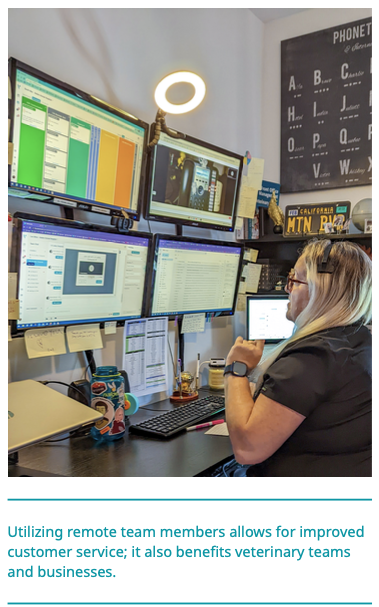
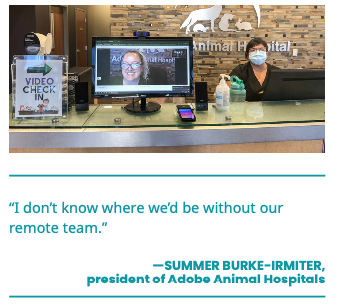
Benefits for Veterinary Hospitals
While utilizing remote team members allows for improved customer service, it also benefits veterinary teams and businesses. In- hospital team members are more efficient and less stressed when some of the phone calls are removed from their plates. They can focus on the clients and patients in front of them knowing that clients calling in are in capable hands. Appointments and surgical procedures are scheduled more efficiently when dedicated remote team members can handle the process. At Adobe Animal Hospital, surgical scheduling that previously took several days can now be done in a matter of hours by a remote team member.
“Even before COVID, our industry was having issues with stang,” said Burke- Irmiter. Utilizing remote employees allows clinics to hire from a wider talent pool since commute times and cost of living in the area are no longer limiting factors. Contracting with a company such as Chronos has the added advantage of reducing the cost of hiring, onboarding, and training since Chronos provides these services. “When ‘remote’ became cool [because of COVID], we already had the technology and the protocols in place,” said Zeltzman. “When colleagues’ teams got ravaged by COVID, we were able to help them continue to function, despite the increased demand for services.”
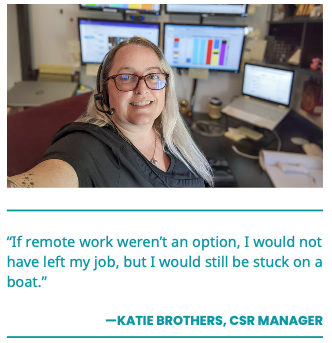
One of the bene�ts Zeltzman hadn’t anticipated was increased revenue. In the �first month of using virtual CSRs, his clinic saw a 10% increase in revenue. They later realized this “was because of improved compliance. Suddenly, in-house receptionists had time to educate clients and improve the bond with them because they weren’t interrupted by phone calls every 30 seconds,” he shared.
Advantages for Remote Team Members
Individuals may pursue remote work opportunities in the veterinary eld for a variety of reasons. “We routinely receive thank you notes from our remote receptionists and nurses,” Zeltzman stated. “They explain that without Chronos, they would have left the eld. There are multiple reasons for that: burnout, aches and pains, taking care of a child with special needs or aging parents, frequent moves to a new state when the spouse is in the military, and a variety of medical conditions.”
For Katie Brothers, CSR manager at Adobe Animal Hospital, the cost of living in the Bay Area prompted her to move from an in-person position with the clinic to remote work. “I had been living on a sailboat for 10 years to make things work,” she shared. “I am lucky to work for a company who was willing and able to �nd a solution that worked for everyone. If remote work weren’t an option, I would not have left my job, but I would still be stuck on a boat.” Instead, Brothers now owns a home on dry land, while still remaining an employee of Adobe.
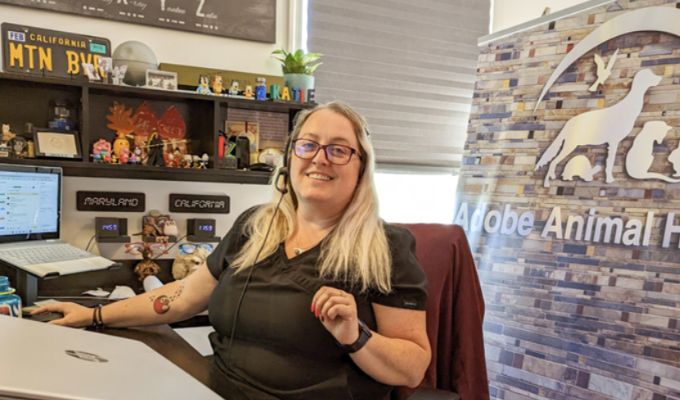
Many virtual employees �and that they have improved work-life balance, reduced stress, and improved productivity with the ability to work from home. While many miss having hands-on time with the patients, they do enjoy working with their own pets by their sides and are glad to have the opportunity to stay in the �eld in a new way.
Challenges of the Virtual World
Remote work is not without its challenges—for both the clinic and the individuals working remotely. Burke-Irmiter noted that just as there can be conflicts within different areas of the in-hospital team, conflicts can arise between the remote and in-hospital teams. The key to solving this is ensuring clear, constant communication and making sure all team members feel like they are part of the team, whether they work in the clinic or from their own home.
She noted that some employees were “nervous about working with someone who had never worked physically in our hospital,” as the new employees wouldn’t know the specific clinic protocols and culture of the clinic. Adobe now contracts with Chronos to provide most of their remote employees, and Chronos helps to nd the right people for each individual hospital.
For some employees, the transition from in-clinic work to remote work can be challenging. “A lot of people haven’t worked remotely before,” noted Burke-Irmiter. She has watched some employees struggle with isolation when not having coworkers nearby during the workday. Additionally, there are some misconceptions about remote work, most notably that it is “easier.” Her remote team members are often completing a variety of tasks within a day and stay busy providing customer service and support to the in-clinic team.
Brothers noted that “when you get busy, it is very easy to sit for too long,” and remote employees should make a point to move around regularly to maintain their physical and mental health. Additionally, while work-life balance may be improved by eliminating commuting time, some remote workers nd it hard to leave their work to working hours since their oce is right down the hall. With support from colleagues, even if in a virtual format, many of these challenges can be overcome.
Utilizing remote workers also increases costs and technology-associated challenges. Both remote workers and clinics must have the right equipment, with the right cybersecurity features, and a reliable internet connection. Burke-Irmiter shared that the cost to set up a new remote worker was around $10,000 per person when they started. Before making this investment, she wanted to be sure that the employee was committed to remote work and Adobe Animal Hospital. One of the advantages of working with Chronos is that they provide the necessary equipment and IT support to keep the remote team running smoothly and safely, which reduces technology costs for the clinic.
Is a Virtual Team for You?
According to Zeltzman, virtual team members are “the ultimate win-win-win-win. In-house team members are less stressed, remote team-members can work from home, customer service improves, and patients are better taken care of.
That combination is hard to beat!”
While the concept may not be for everyone, Burke-Irmiter expressed her hope that “more hospitals will embrace this idea to help supplement in-house teams.” For those who are interested in adding remote team members or allowing some of their existing team members to move to remote work, “contracting [with a company] is a great way to get started,” shared Burke-Irmiter.
 Kate Boatright, VMD, has been in small animal practice since graduating from the University of Pennsylvania in 2013. After nearly 8 years of working full-time in both general practice and emergency clinics, she moved to part-time work to pursue her passion for educating veterinary professionals as a freelance speaker and author.
Kate Boatright, VMD, has been in small animal practice since graduating from the University of Pennsylvania in 2013. After nearly 8 years of working full-time in both general practice and emergency clinics, she moved to part-time work to pursue her passion for educating veterinary professionals as a freelance speaker and author.
Photo credits: Photos courtesy of Adobe Animal Hospital

